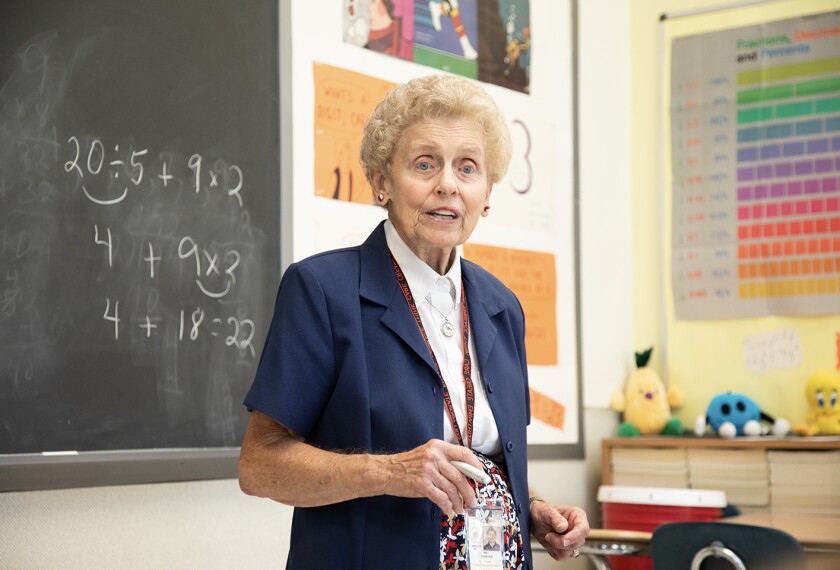Voters have never approved a ballot initiative that paves the way for private school choice. But that could change this November as several states put before voters the question of public funding for private education.
Colorado, Kentucky, and Nebraska will ask voters on Election Day whether they support laying the groundwork for more state-funded private school choice, and in one case, halting an existing program that offers public dollars for parents to spend on private schooling.
In Utah, meanwhile, critics of private school choice believe that if a proposed constitutional amendment is successful, it could free up more state funds for the state’s education savings account program, which is currently accessible to all students statewide.
Private school choice has become one of the most hotly debated issues in K-12 education since the start of the pandemic. Since then, roughly a dozen states have enacted state-funded private school choice offerings that are or will eventually be open to all students.
Other states have expanded eligibility and funding for existing programs that make public funds available for private education or created new programs with more narrowly targeted eligibility criteria.
Lawmakers in Idaho, Tennessee, and Texas have recently signaled plans to revive private school choice legislation next year.
Presidential nominees Kamala Harris and Donald Trump haven’t spent much time detailing their views on private school choice during their campaigns. But the Republican Party platform includes a call for universal school choice in every state. Project 2025, the massive conservative policy agenda crafted by the Heritage Foundation and many who served in the first Trump administration, calls for allowing parents to spend federal education funds on private school expenses. The Democratic Party platform, meanwhile, calls vouchers, tax-credit scholarships, and other private school choice mechanisms “schemes that divert taxpayer-funded resources away from public education.”
Proponents of private school choice hope the increased prominence and reach of these policies will spur voters to support additional expansion.
Here’s a state-by-state guide to the key contests to watch.
Colorado
Voters will decide whether to enshrine in the state constitution that all students “have a right to school choice.” If “yes” prevails, examples of school choice mentioned in the new addition to the constitution would include “neighborhood schools, charter schools, private schools, home schools, open-enrollment options, and future innovations in education.” The initiative needs support from 55 percent of voters to pass.
A growing school choice movement has swept Republican state legislatures as the COVID-19 pandemic reoriented many parents’ educational priorities for their children. Teachers’ unions and public school advocates worry that the amendment would presage a push for vouchers or education savings accounts in Colorado, where Democrats control the governor’s office and both chambers of the legislature. Organizations behind the ballot initiative say they want to lock in existing regulations that allow for the proliferation of charter schools.
Colorado does not have any private school choice programs. Lawmakers have tried several times in the last two decades to introduce one, to no avail. In 2003, a Denver judge struck down a school voucher program on the grounds that it robbed districts of local control.
Kentucky
Voters will decide whether to amend the state constitution to explicitly allow the state to fund education options outside the public school system. The initiative needs a simple majority of votes in favor to pass.
This amendment is the highest-profile contest on the Kentucky ballot this November, after the presidential election. If voters approve it, and the state subsequently passes private school choice legislation that’s comparable to other states’ programs, Kentucky could be spending more than $1 billion a year on education savings accounts, according to an estimate by the left-leaning Kentucky Center for Economic Policy. The amendment could also pave the way for Kentucky to become one of the last states to approve charter schools.
The initiative’s supporters counter that the amendment wouldn’t create a new program but simply lay the groundwork for closer consideration of private school choice. Gov. Andy Beshear, a Democrat, and public school advocates are urging voters to reject the proposal, arguing that the amendment will harm public schools’ budgets and the services they provide to students.
Twice in recent years, courts have struck down conservative lawmakers’ school choice policies. In 2022, the state supreme court rejected a plan to spend public funds on tax-credit scholarships for private education. The following year, a county circuit court judge nixed lawmakers’ attempt to provide funding for charter schools. Supporters of these proposals believe a constitutional amendment will bolster future efforts to promote school choice.
Nebraska
Voters will decide whether to retain or repeal the state’s newly passed private school choice program, which allocates $10 million a year for parents to spend on a wide range of private educational expenses. A simple majority will determine the existing law’s fate.
This initiative is the only one on any state ballot this fall that could, depending on the outcome, immediately eliminate an existing private school choice program.
At the start of 2024, Nebraska had an entirely different private school choice policy on the books: the Opportunity Scholarships Act, a tax-credit scholarship program. Support Our Schools, the coalition of public school advocates behind Referendum 435, secured space on the November ballot for a different referendum that would have undone the original program.
To skirt the potential challenge from voters, lawmakers repealed the Opportunity Scholarships Act and replaced it with a similar program with a lower cost. Funds for this program’s offerings to parents come directly from state coffers rather than relying on a tax-credit funding mechanism. Support Our Schools subsequently secured enough signatures to put Referendum 435 on the ballot, tasking voters with determining whether Nebraska’s second iteration of private school choice will stand or not.
Most recently, supporters of the program tried to persuade the Nebraska supreme court to knock the new referendum off the ballot. But the court ruled Sept. 13 that it should stay on.
Utah
Voters will decide whether to amend the state’s constitution so that the state can invest income and some property tax revenue “to be used for all state needs,” rather than solely for public education, higher education, and services for children with disabilities, as the state constitution currently authorizes. The initiative would also enshrine the state’s current public school funding formula in the state constitution and trigger a law that would eliminate a 1.75 percent state sales tax on food. The measure needs a simple majority of voters to pass.
Democratic lawmakers contend that the wording of the initiative may mislead voters who choose “yes” into thinking they’re solely supporting public education spending, when in fact they would also support allowing money that’s currently spent largely on public education to be spent on any other priority as the state sees fit. They’ve also raised concerns about attaching the unrelated sales-tax provision to passage of the amendment.
“They are making voters who vote ‘no’ feel bad about not wanting to help hungry families,” Sarah Reale, a member of Utah’s state board of education, told The Salt Lake Tribune.
Lawmakers who support the proposed amendments want to give the state more flexibility to spend tax revenue as needed. They also want to codify in the constitution the state’s approach to school funding, which accounts for enrollment fluctuations and sets aside a certain share of funding in a state savings account that can only be used for K-12 education.
For most of the 20th century, Utah spent income tax revenue solely on public K-12 education. In 1996, voters approved opening up those funds to higher education as well, and in 2020, they voted again to approve also spending that money on services for children with disabilities.
Since then, the state has also poured more than $83 million into a universal education savings account program that provides families with access to public money that they can use on private education expenses. The state teachers’ union is currently challenging that program in court. Opponents of the program fear it could be a target for increased investment if the constitutional amendment passes and income tax revenue can be spent on anything.
One more contest to watch
In Ohio, voters’ choices for seats on the state supreme court will determine the court’s partisan balance. Victories in all three races for Democrats would mean the court would flip to Democratic control, 4-3. Victories in all three races for Republicans would strengthen the GOP’s majority to 6-1.
That outcome could affect the fate of the state’s voucher program, if a current legal challenge from dozens of districts ends up before the state supreme court. Republicans tend to be more favorably inclined toward private school choice than Democrats.
Disclaimer: The copyright of this article belongs to the original author. Reposting this article is solely for the purpose of information dissemination and does not constitute any investment advice. If there is any infringement, please contact us immediately. We will make corrections or deletions as necessary. Thank you.







